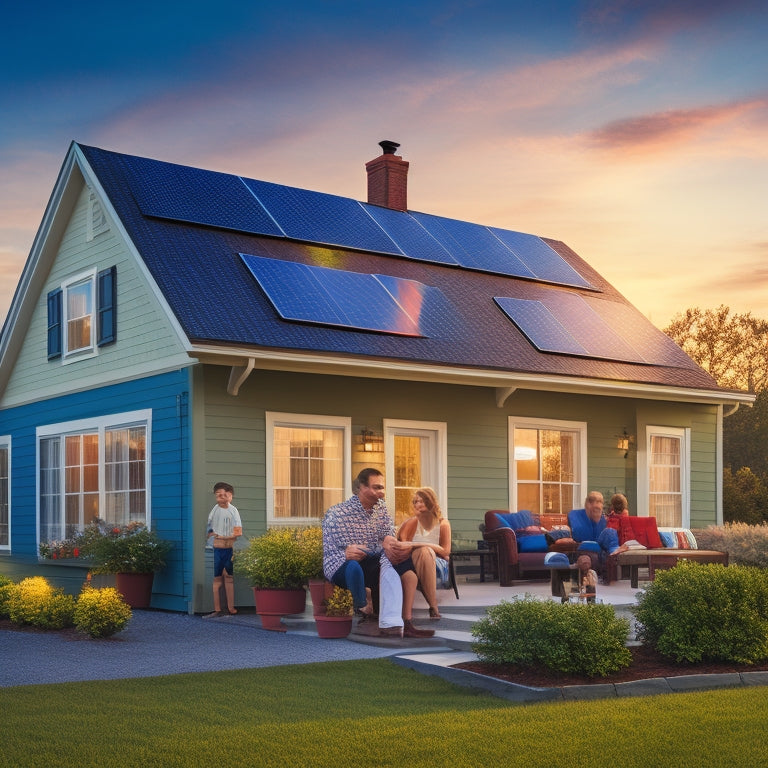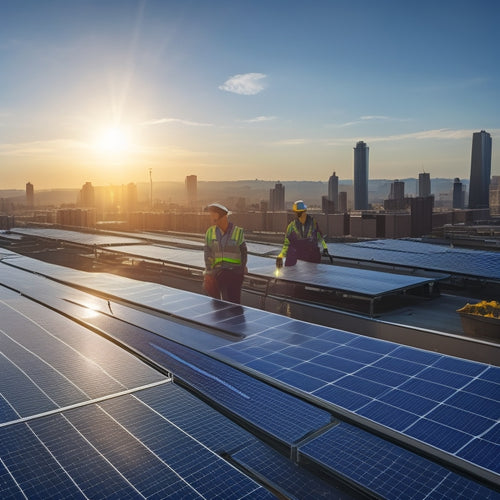
What's the True Cost of Solar Panel Ownership?
Share
To determine the true cost of solar panel ownership, consider the initial purchase price, often between $2.50 and $3.50 per watt for a 6kW system. Premium brands like SunPower or LG may cost more but offer higher energy output and durability. Installation fees vary widely and can include hidden costs. Government incentives, like federal tax credits, can substantially reduce your upfront investment. Beyond the initial costs, factor in maintenance, repair expenses, and potential energy savings through net metering. Financing options like loans or leases also affect your total expenditure. Understanding these elements will give you a clearer financial picture.
Key Takeaways
- Initial purchase cost ranges from $2.50 to $3.50 per watt for a 6kW system, varying by brand and quality.
- Government incentives and rebates can significantly reduce the initial cost of solar panel installation.
- Maintenance, including cleaning and inspections, is essential for long-term efficiency and system lifespan.
- Ownership involves repair costs for issues like microcracks, inverter failures, and wiring problems.
- Financing options like loans and leases affect long-term savings and cost structure.
Initial Purchase Cost
https://www.youtube.com/watch?v=DSpNHtFWcn0
The initial purchase cost of solar panels can vary considerably based on factors like system size, quality of panels, and installation complexity. When selecting a brand, you'll notice that premium brands often come with higher price tags but offer superior efficiency and longevity. For example, brands like SunPower or LG may cost more upfront but can provide better energy output and durability over time.
Current market trends indicate a decrease in solar panel costs due to advancements in technology and increased competition. In 2023, you can expect to pay between $2.50 and $3.50 per watt, translating to $15,000 to $21,000 for an average 6kW system before any incentives. However, the market is highly dynamic; keeping an eye on trends can help you identify the best time to invest.
Brand choice doesn't just affect cost but also impacts performance and warranty terms. Some brands offer extended warranties and robust customer support, which can be essential for long-term satisfaction.
Installation Fees
Beyond the initial purchase cost, installation fees greatly impact the total expense of owning solar panels. These fees can sometimes be obscured by hidden charges, making it essential to scrutinize every detail when selecting a contractor.
The average installation cost in the U.S. hovers around $2.93 per watt, but this can vary greatly based on your location, roof type, and the complexity of the installation.
To make sure you're making an informed decision, consider the following:
-
Hidden Fees: Always ask for a detailed breakdown of costs. Some contractors may not include essential components like inverters or mounting hardware in their initial quote, leading to unexpected expenses.
-
Contractor Selection: The expertise and reputation of the contractor can significantly impact the installation quality and cost. Look for contractors with industry certifications and strong customer reviews. Cheaper isn't always better if it compromises the system's efficiency and longevity.
-
Permits and Inspections: These are often overlooked but are important for compliance and safety. Verify that your quote includes permit application fees and inspection costs, which can add up to $1,000 or more.
Government Incentives
You should consider government incentives like federal tax credits and state rebate programs, which can greatly reduce your solar panel costs.
Federal tax credits currently offer up to 26% off your installation expenses, while state-specific rebates vary but can further lower initial outlays.
These financial incentives make solar energy more affordable and accelerate your return on investment.
Federal Tax Credits
Often, federal tax credits greatly reduce the initial cost of solar panel installation, making renewable energy more accessible for homeowners. The Federal Investment Tax Credit (ITC) allows you to deduct 30% of the cost of installing a solar energy system from your federal taxes. Importantly, understanding the eligibility criteria and the claim process can maximize these savings.
To be eligible for the ITC, you must meet the following criteria:
- Ownership: You must own the solar panel system; leased systems don't qualify.
- Residential Use: The system must be installed at a residential property.
- Timing: The system must be installed and operational within the tax year you're claiming the credit.
The claim process is straightforward but requires attention to detail. You'll need to complete IRS Form 5695 and include it with your federal tax return. This form calculates your credit and ensures it's correctly applied. Keep all receipts and contracts, as the IRS may require documentation to verify your claim.
Understanding these aspects can significantly lower your financial barrier to adopting solar energy, empowering you to take control of your energy consumption and contribute to a sustainable future.
State Rebate Programs
State rebate programs offer additional financial incentives that can further reduce the cost of solar panel ownership, making the investment even more attractive. These programs vary by state and provide you with local benefits that can greatly lower your upfront expenses. By taking advantage of these rebates, you can enjoy faster payback periods and greater long-term savings.
Understanding program eligibility is essential. Eligibility criteria can include factors like system size, installation date, and compliance with state-specific regulations. Here's a snapshot of some state rebate programs:
| State | Rebate Amount | Eligibility Criteria |
|---|---|---|
| California | Up to $1,000 per kW | Residential and commercial properties |
| New York | $0.40 per watt | Systems up to 25kW |
| Texas | $2,500 to $8,500 total | Varies by utility provider |
| Massachusetts | $1,200 per kW | Residential systems up to 20kW |
Don't overlook the local benefits of these programs. State rebates can be combined with federal tax credits to maximize your savings. Additionally, some states offer performance-based incentives, which reward you for the electricity your system produces over time. By researching and applying for these state rebates, you're not just cutting costs—you're investing in energy independence and reducing your carbon footprint.
Energy Savings
Investing in solar panels can greatly reduce your electricity bills by generating renewable energy directly from sunlight. This not only cuts down on your monthly utility bills but also offers efficiency gains that can have a substantial impact on your overall energy expenditure. Here's how you can maximize your energy savings:
-
Efficiency Gains: Modern solar panels have improved efficiency rates, converting more sunlight into usable electricity. With efficiency rates often exceeding 20%, you can harness more energy even on cloudy days.
-
Net Metering: Many states offer net metering programs that allow you to sell excess electricity back to the grid. This can offset your utility bills, sometimes even leading to a negative balance, where the utility company owes you.
-
Peak Shaving: By using stored solar energy during peak demand times, you can avoid high electricity rates. Advanced solar systems with battery storage let you store excess energy generated during the day for use at night or during high-demand periods.
These factors collectively contribute to substantial energy savings, giving you more control over your energy consumption and financial freedom.
Financing Options
When considering financing options for solar panels, you'll need to weigh the benefits of loans versus leases. Loans often offer ownership benefits and potential tax credits, while leases can provide lower upfront costs.
Additionally, look into various incentives and rebates available in your region that can greatly reduce overall expenses.
Loan Vs. Lease
Choosing between a loan and a lease for solar panel financing hinges on understanding the long-term costs, potential savings, and ownership benefits each option offers. When you opt for a loan, you'll own the system outright once the loan is paid off, typically in 7 to 20 years. This route often comes with contract terms that include interest rates and monthly payments. Loans can be more cost-effective in the long run because you'll benefit from energy savings and potential home value increases.
Leasing, on the other hand, involves paying a fixed monthly fee to use the solar panels, usually over a 20 to 25-year contract duration. You won't own the system, but the leasing company often handles maintenance and repairs. While leases might offer lower upfront costs, you won't receive the same long-term financial benefits as ownership.
Consider these factors when deciding:
-
Ownership Duration: Loans result in ownership, while leases do not.
-
Contract Terms: Loans have specific interest rates and payment schedules; leases have fixed monthly fees.
-
Long-Term Savings: Loans generally offer higher long-term savings through energy cost reductions and incentives.
Incentives and Rebates
As you weigh the benefits of loans versus leases, it's important to also consider the array of incentives and rebates available to reduce the overall cost of solar panel ownership.
Local incentives play an essential role in diminishing your upfront expenses. Many states and municipalities offer tax credits, grants, or performance-based incentives. These can greatly lower your initial investment, making solar panels more financially accessible.
Utility rebates are another key factor. Many utility companies provide rebates to encourage renewable energy adoption. These rebates vary widely in amount and structure, often covering a specific dollar amount per watt installed or a percentage of the total installation cost. For instance, some programs offer up to $0.50 per watt, translating to substantial savings on a typical 5 kW system.
Additionally, the federal Investment Tax Credit (ITC) allows you to deduct 26% of your solar installation cost from your federal taxes, a considerable reduction in your overall expenditure.
Combining these incentives and rebates can make solar ownership not just feasible but also economically advantageous.
Warranty Types
Understanding the various warranty types for solar panels is essential in evaluating their long-term value and performance. When comparing options, you'll encounter three main types of warranties: product, performance, and labor. Each comes with its own specifics and coverage period, which can greatly influence your investment's viability.
-
Product Warranty: This covers defects in materials and workmanship, typically lasting between 10-25 years. It's your safeguard against manufacturing flaws.
-
Performance Warranty: Solar panels degrade over time, but this warranty ensures they don't fall below a certain efficiency threshold. Most performance warranties guarantee 90% efficiency for the first 10 years and 80% for up to 25 years.
-
Labor Warranty: Often, this is provided by the installer, covering the cost of labor for repairs or replacements. Coverage periods vary, so check the specifics.
Knowing if a warranty is transferable is essential if you plan to sell your property. A transferable warranty can be passed on to the new owner, enhancing your home's market value.
Maintenance Requirements
Regular maintenance of solar panels is essential to guarantee peak performance and longevity, often involving periodic cleaning and inspections for damage or debris. You'll need to be proactive about meeting your cleaning needs, especially in areas prone to dust, pollen, or bird droppings. Consistent upkeep ensures your system's efficiency isn't compromised by dirt accumulation, which can reduce sunlight absorption.
Inspections should include checking for any physical damage or obstructions. It's also important to monitor the inverter, a key component that might require replacement every 10-15 years. Inverters convert the DC electricity produced by solar panels into AC electricity used by your home. A failing inverter can severely impact your system's output.
Here's a brief overview of the primary maintenance tasks:
| Task | Frequency |
|---|---|
| Panel Cleaning | Bi-annually |
| Inspection for Damage | Annually |
| Inverter Replacement | Every 10-15 years |
Repair Costs
When considering repair costs for solar panels, you'll need to account for common issues like microcracks and inverter failure.
Labor costs can vary considerably, with averages ranging from $100 to $300 per hour depending on your location.
Don't forget to review warranty terms, as many can cover specific repairs for up to 25 years, reducing your out-of-pocket expenses.
Common Repair Issues
Solar panel owners frequently encounter repair issues such as inverter failures, panel microcracks, and wiring problems, which can lead to varying repair costs. Understanding these common issues helps you anticipate potential expenses and maintain your system efficiently.
-
Micro cracks formation: These minor fractures can develop in your solar panels over time due to thermal cycling, mechanical stress, or improper handling. Microcracks might seem insignificant, but they can reduce your system's efficiency by disrupting the flow of electricity. Repairing or replacing affected panels might cost you anywhere from $100 to $400 per panel.
-
Inverter malfunction: Inverters, which convert DC electricity from your panels into usable AC electricity, are prone to failures. Common causes include overheating, component wear, and electrical surges. Inverter repairs can range from $500 to $2,500, depending on the type and extent of the damage.
-
Wiring problems: Faulty or degraded wiring can lead to poor energy transmission and safety hazards. Issues often arise from weather exposure, rodent damage, or improper installation. Repairing wiring problems might set you back between $100 and $1,000, depending on the complexity of the issue.
Cost of Labor
Labor costs for repairing solar panel systems can greatly impact your overall maintenance budget, with technicians typically charging between $50 and $150 per hour. These technician rates can vary widely depending on location, complexity of the repair, and the experience of the technician. For instance, highly specialized repairs might demand the higher end of the spectrum or even exceed it.
It's essential to factor in these costs when planning for long-term solar panel ownership. Some companies offer labor warranties that cover these expenses for a certain period, generally ranging from 5 to 10 years. If your system's labor warranty is robust, you might save significantly on repair costs. However, if your labor warranty has expired or is limited, you should be prepared for out-of-pocket expenses.
Additionally, consider the frequency of needed repairs. Systems in harsher climates might require more frequent maintenance, thereby increasing labor costs over time. Understanding technician rates and the scope of your labor warranty can help you budget more accurately and avoid unexpected financial burdens.
Warranty Considerations
Evaluating your solar panel system's warranty can greatly impact your overall repair costs and long-term investment returns. A robust warranty offers peace of mind, but it's important to scrutinize the details. Your warranty's coverage period determines how long you're protected against potential defects and performance issues. Typically, warranties last between 10 to 25 years, guaranteeing you don't bear unexpected repair costs during this time.
When appraising warranties, consider these key factors:
-
Coverage Period: Longer warranties provide extended protection, reducing out-of-pocket expenses for repairs. Compare different manufacturers to find the best balance between initial cost and coverage duration.
-
Claim Process: A straightforward claim process minimizes downtime and hassle. Research customer reviews and manufacturer reputations to make sure of prompt and efficient service.
-
Inclusions and Exclusions: Understand exactly what's covered. Some warranties include labor costs for repairs, while others solely cover parts. Check for exclusions that might leave you vulnerable to additional expenses.
Performance Monitoring
To guarantee your solar panel system operates at peak efficiency, regular performance monitoring is essential for identifying and addressing any issues promptly. By leveraging remote monitoring, you can keep a constant eye on your system's output from virtually anywhere. This not only minimizes downtime but also maximizes energy production. Most modern solar installations come equipped with sophisticated remote monitoring tools that provide real-time data on energy generation, system health, and even weather conditions affecting performance.
Software updates are another critical component of performance monitoring. Regular updates guarantee your monitoring system incorporates the latest algorithms and analytics for more accurate diagnostics. These updates can also introduce new features that enhance user experience and system efficiency. Neglecting software updates could lead to outdated performance metrics, potentially costing you in lost energy production.
Long-Term Value
Maximizing the long-term value of your solar panel system requires a strategic approach to both maintenance and financial planning. You can greatly extend the lifespan and efficiency of your system by focusing on these key areas.
-
Regular Maintenance: Guarantee your panels are cleaned and inspected regularly. Dust, debris, and snow accumulation can reduce efficiency by up to 25%. Scheduling professional maintenance can help you spot potential issues early and avoid costly repairs.
-
Financial Incentives: Take advantage of government incentives, tax credits, and rebates. These can substantially reduce your initial investment and increase your system's resale value. For instance, the Federal Solar Tax Credit offers a 26% deduction on your taxes.
-
Environmental Impact: Solar panels reduce your carbon footprint. Over a 25-year lifespan, a typical residential solar system can offset approximately 100,000 pounds of CO2. This not only benefits the planet but also boosts your property's appeal to eco-conscious buyers, positively affecting resale value.
Frequently Asked Questions
How Do Solar Panels Affect My Home Insurance Premiums?
Solar panels can lower your home insurance premiums through insurance discounts if your roof compatibility is ideal. Proper installation reduces risks, enhancing safety and reliability, which insurers often recognize with reduced rates, freeing you financially.
What Is the Environmental Impact of Solar Panel Production?
When you dig into the environmental impact of solar panel production, you'll see that resource extraction and waste management are significant issues. However, advances in recycling and sustainable materials are turning the tide towards greener solutions.
Can Solar Panels Increase My Property Value?
Yes, solar panels can increase your property value. Data shows homes with solar installations tend to sell at a premium. However, consider potential property taxes impacts, as they may offset some of the resale value benefits.
Are There Any Aesthetic Options for Solar Panels?
Verily, you've got aesthetic options! Consider solar shingles for a seamless look, and explore various color options to match your roof. These innovations guarantee energy efficiency without sacrificing style, liberating you from traditional panel aesthetics.
How Do Solar Panels Perform in Extreme Weather Conditions?
In extreme weather conditions, solar panels maintain energy efficiency but require increased maintenance frequency. Advanced designs withstand harsh environments, ensuring minimal performance loss. You'll experience reliable energy while embracing freedom from traditional power sources.
Related Posts
-

Solar Installation Guide for Commercial Properties
Implementing solar energy solutions in your commercial property can lead to significant long-term savings and sustain...
-

Long-Term Cost Savings With Solar Panels
Investing in solar panels offers substantial long-term savings on energy costs. You'll benefit from federal tax credi...
-

Energy-Efficient Heating and Cooling Appliances
Energy-efficient heating and cooling appliances can cut your energy bills markedly. By opting for models with high En...


